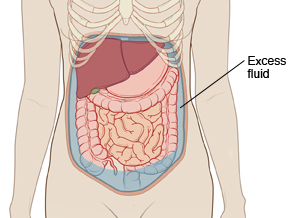Discharge Instructions for Paracentesis
Paracentesis is a procedure to remove extra fluid from your belly (abdomen). This fluid buildup in the abdomen is called ascites. The procedure may have been done to take a sample of the fluid. Or, it may have been done to drain the extra fluid from your abdomen and help make you more comfortable.
 |
| Ascites is buildup of excess fluid in the abdomen. |
Home care
-
If you have pain after the procedure, your healthcare provider can prescribe or recommend pain medicines. Take these exactly as directed. If you stopped taking other medicines before the procedure, ask your provider when you can start them again.
-
Take it easy for 24 hours after the procedure. Don't do any physical activity until your provider says it’s OK.
-
You will have a small bandage over the puncture site. Stitches, surgical staples, adhesive tapes, adhesive strips, or surgical glue may be used to close the cut (incision). They also help stop bleeding and speed healing. You may take the bandage off in 24 hours.
-
Check the puncture site for the signs of infection listed below.
Follow-up care
Make a follow-up appointment with your healthcare provider as directed. During your follow-up visit, your provider will check your healing. Let your provider know how you are feeling. You can also discuss the cause of your ascites and if you need any further treatment. If your fluid is infected, you will be sent home on antibiotics. In some cases, the paracentesis may need to be repeated if the fluid returns. Your provider may also prescribe medicines that increase urination (diuretics) to decrease the buildup of fluid.
When to call your healthcare provider
Call your healthcare provider if any of the following occur:
-
Fever of 100.4° F ( 38°C) or higher, or as directed by your provider
-
Chills
-
Trouble breathing
-
Pain that doesn't go away even after taking pain medicine
-
Belly pain not caused by having the skin punctured
-
Bleeding from the puncture site
-
More than a small amount of fluid leaking from the puncture site
-
Swollen belly
-
Signs of infection at the puncture site. These include increased pain, redness, or swelling, warmth, or bad-smelling drainage.
-
Blood in your urine
-
Feeling dizzy or lightheaded, or fainting
Online Medical Reviewer:
Jen Lehrer MD
Online Medical Reviewer:
L Renee Watson MSN RN
Online Medical Reviewer:
Marianne Fraser MSN RN
Date Last Reviewed:
5/1/2022
© 2000-2025 The StayWell Company, LLC. All rights reserved. This information is not intended as a substitute for professional medical care. Always follow your healthcare professional's instructions.